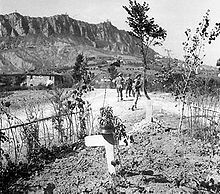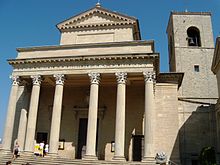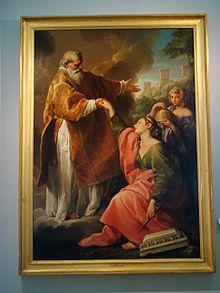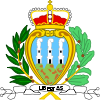- San Marino
-
This article is about the country in southern Europe. For other uses, see San Marino (disambiguation).
Republic of San Marino Repubblica di San Marino

Flag Coat of arms Motto: Libertas (Latin)
"Freedom"Anthem: "Inno Nazionale della Repubblica"
"National Anthem of the Republic"Location of San Marino (green)in Europe (dark grey) — [Legend]
Capital City of San Marino
43°56′N 12°26′E / 43.933°N 12.433°ELargest city Dogana Official language(s) Italian Ethnic groups Italian Demonym Sammarinese Government Parliamentary republic - Captains Regent Gabriele Gatti
Matteo FioriniIndependence - from the Roman Empire 3 September 301 (traditional) - Constitution 8 October 1600 Area - Total 61.2 km2 [1](219th)
24 sq mi- Water (%) 0 Population - 31 March 2011 estimate 31,887 [2] (211th) - Density 501/km2
1,297.6/sq miGDP (PPP) 2008 estimate - Total $1.17 billion[3][4] (177th) - Per capita $35,928[3][4] (24th) GDP (nominal) 2008 estimate - Total US$1.44 billion[3][4] (163rd) - Per capita US$44,208[3][4] (15th) Currency Euro ( EUR)Time zone CET (UTC+1) - Summer (DST) CEST (UTC+2) Drives on the right ISO 3166 code SM Internet TLD .sm Calling code +378 Patron saint St. Agatha [1][5] San Marino, officially the Republic of San Marino[1][6] (
 i/sæn məˈriːnoʊ/ san-mə-ree-noh; Italian: Repubblica di San Marino, also known as the Most Serene Republic of San Marino[6]), is a state situated on the Italian Peninsula on the eastern side of the Apennine Mountains. It is an enclave surrounded by Italy. Its size is just over 61 km2 (24 sq mi) with an estimated population of over 30,000. Its capital is the City of San Marino. San Marino has the smallest population of all the members of the Council of Europe.
i/sæn məˈriːnoʊ/ san-mə-ree-noh; Italian: Repubblica di San Marino, also known as the Most Serene Republic of San Marino[6]), is a state situated on the Italian Peninsula on the eastern side of the Apennine Mountains. It is an enclave surrounded by Italy. Its size is just over 61 km2 (24 sq mi) with an estimated population of over 30,000. Its capital is the City of San Marino. San Marino has the smallest population of all the members of the Council of Europe.San Marino is the oldest surviving sovereign state and constitutional republic in the world, as the continuation of the monastic community founded on 3 September 301, by stonecutter Marinus of Rab. Legend has it that Marinus left Rab, then the Roman colony of Arba, in 257 when the future emperor, Diocletian, issued a decree calling for the reconstruction of the city walls of Rimini, which had been destroyed by Liburnian pirates.[7]
The constitution of San Marino, enacted in 1600, is the world's oldest constitution still in effect.[8] The country's economy mainly relies on finance, industry, services and tourism. It is one of the wealthiest countries in the world in terms of GDP (per capita), with a figure comparable to some of the more developed Italian regions, such as Lombardy and Trentino-Alto Adige/Südtirol. San Marino is considered to have a highly stable economy, with one of the lowest unemployment rates in Europe, no national debt and a budget surplus.[1]
Contents
History
Main article: History of San Marino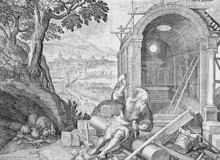 Illustration of Saint Marinus, the founder of the Republic of San Marino, and prominent cultural figure
Illustration of Saint Marinus, the founder of the Republic of San Marino, and prominent cultural figure
According to tradition, Saint Marinus left the island of Rab in present-day Croatia with his lifelong friend Leo, and went to the city of Rimini as a mason. After the Diocletianic Persecution following his Christian sermons, he escaped to the nearby Monte Titano, where he built a small church and thus founded what is now the city and state of San Marino. The official date of foundation of the Republic is 3 September 301.
By the mid-5th century, a community was formed; because of its relatively inaccessible location and its poverty, it has succeeded, with a few brief interruptions, in maintaining its independence. In 1631, its independence was recognized by the Papacy.
The advance of Napoleon's army in 1797 presented a brief threat to the independence of San Marino, but the country was saved from losing its liberty thanks to one of its Regents, Antonio Onofri, who managed to gain the respect and friendship of Napoleon. Thanks to his intervention, Napoleon, in a letter delivered to Gaspard Monge, scientist and commissary of the French Government for Science and Art, promised to guarantee and protect the independence of the Republic, offering to extend its territory according to its needs. The offer was declined by San Marino, fearing to provoke future revanchism that might threaten its freedom.[9]
During the later phase of the Italian unification process in the 19th century, San Marino served as a refuge for many people persecuted because of their support for unification. In recognition of this support, Giuseppe Garibaldi accepted the wish of San Marino not to be incorporated into the new Italian state.
The government of San Marino made United States President Abraham Lincoln an honorary citizen. He wrote in reply, saying that the republic proved that "government founded on republican principles is capable of being so administered as to be secure and enduring."[10][11]
20th century
During World War I, when Italy declared war on Austria-Hungary on 23 May 1915, San Marino remained neutral and Italy adopted a hostile view of Sammarinese neutrality, suspecting that San Marino could harbour Austrian spies who could be given access to its new radiotelegraph station. Italy tried to forcibly establish a detachment of Carabinieri in the Republic and then cut the Republic's telephone lines when it did not comply. Two groups of ten volunteers did, however, join Italian forces in the fighting on the Italian front, the first as combatants and the second as a Medical Corps operating a Red Cross field hospital. The existence of this hospital later caused Austria-Hungary to suspend diplomatic relations with San Marino.[12]
From 1923 to 1943, San Marino was under the rule of the Sammarinese Fascist Party (PFS).
During World War II, San Marino remained neutral, although it had been wrongly reported to have declared war on the United Kingdom on 17 September 1940.
Three days after the fall of Benito Mussolini in Italy, PFS rule collapsed and the new government declared neutrality in the conflict. The Fascists regained power on 1 April 1944 but kept neutrality intact. Despite that, on 26 June 1944 San Marino was bombed by the Royal Air Force, which mistakenly believed that the country had been overrun by German forces and was being used to amass stores and ammunition. At least 35 people were killed in the operation. San Marino accepted thousands of civilian refugees when Allied forces went over the Gothic Line.[13] In September 1944, it was briefly occupied by German forces, who were attacked by Allied forces in the Battle of San Marino. Allied troops withdrew from the country shortly afterwards.
San Marino had the world's first democratically elected communist government, which held office between 1945 and 1957 and again between 2006 and 2008.
San Marino is the world's smallest republic, although when Nauru gained independence in 1968 it challenged that claim, Nauru's land mass being only 21 km2 (8.1 sq mi). However Nauru's jurisdiction over its surrounding waters (431,000 km2) is thousands of times greater than the territory of San Marino.[14]
San Marino became a member of the Council of Europe in 1988 and of the United Nations in 1992. It is not a member of the European Union.
Geography
Main article: Geography of San MarinoSan Marino is an enclave in Italy, on the border between the regioni of Emilia Romagna and Marche and about 10 km (6.21 mi) from the Adriatic coast at Rimini. Its topography is dominated by the Apennine mountain range, and it has a rugged terrain. The highest point in the country, the summit of Monte Titano, is situated at 749 m (2,457 ft) above sea level. There are no bodies of water of any significant size. San Marino is the third smallest country in Europe, with only Vatican City and Monaco being smaller. San Marino has no natural level ground; it is entirely composed of hilly terrain.
Climate
The climate is Mediterranean with continental influences, having warm summers and cool winters. The National Centre of Meteorology and Climatology of San Marino provides local forecasts.[15]
Administrative divisions
Municipalities
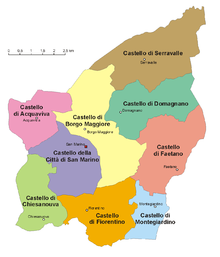 Administrative divisions of San Marino
Administrative divisions of San Marino
San Marino is divided into the following nine municipalities, known locally as castelli (meaning "castles").
- San Marino (City of San Marino, officially Città di San Marino) is the capital.
There are also eight minor municipalities:
- Acquaviva
- Borgo Maggiore
- Chiesanuova
- Domagnano
- Faetano
- Fiorentino
- Montegiardino
- Serravalle
The largest town of the Republic is Dogana, which is not an autonomous castello, but rather belongs to the Castello of Serravalle.
In a similar way to an Italian comune, each castello includes a main settlement, called capoluogo, which is the seat of the castello, and some even smaller localities known as frazioni.
Hamlets
The republic is made up of 43 hamlets[16] named curazie:
Cà Berlone, Cà Chiavello, Cà Giannino, Cà Melone, Cà Ragni, Cà Rigo, Cailungo, Caladino, Calligaria, Canepa, Capanne, Casole, Castellaro, Cerbaiola, Cinque Vie, Confine, Corianino, Crociale, Dogana, Falciano, Fiorina, Galavotto, Gualdicciolo, La Serra, Lesignano, Molarini, Montalbo, Monte Pulito, Murata, Pianacci, Piandivello, Poggio Casalino, Poggio Chiesanuova, Ponte Mellini, Rovereta, San Giovanni sotto le Penne, Santa Mustiola, Spaccio Giannoni, Teglio, Torraccia, Valdragone, Valgiurata and Ventoso.Politics
Main article: Politics of San MarinoSee also: Foreign relations of San Marino, Constitution of San Marino, Capital punishment in San Marino, San Marino passport, Law enforcement in San Marino, and Elections in San Marino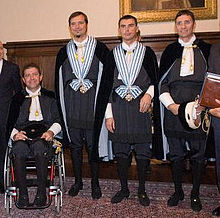 Former Captains Regent Mirko Tomassoni, Alessandro Rossi, Alessandro Mancini, and Alberto Selva. (from left to right)
Former Captains Regent Mirko Tomassoni, Alessandro Rossi, Alessandro Mancini, and Alberto Selva. (from left to right)
San Marino has the political framework of a parliamentary representative democratic republic: the Captains Regent are the heads of state, and there is a pluriform multi-party system. Executive power is exercised by the government. Legislative power is vested in both the government and the Grand and General Council. The judiciary is independent of the executive and the legislature.
San Marino was originally led by the Arengo, initially formed from the heads of each family. In the 13th century, power was given to the Great and General Council. In 1243, the first two Captains Regent were nominated by the Council. As of 2010[update], this method of nomination is still in use.
The legislature of the republic is the Grand and General Council (Consiglio grande e generale). The Council is a unicameral legislature with 60 members. There are elections every five years by proportional representation in all nine administrative districts. These districts (townships) correspond to the old parishes of the republic.
Citizens 18 years or older are eligible to vote. Beside general legislation, the Grand and General Council approves the budget and elects the Captains Regent, the State Congress (composed of ten Secretaries with executive power), the Council of Twelve (which forms the judicial branch during the period of legislature of the Council), the Advising Commissions, and the Government Unions. The Council also has the power to ratify treaties with other countries. The Council is divided into five different Advising Commissions consisting of fifteen councillors who examine, propose, and discuss the implementation of new laws that are on their way to being presented on the floor of the Council.
Every six months, the Council elects two Captains Regent to be the heads of state. The Regents are chosen from opposing parties so that there is a balance of power. They serve a six-month term. The investiture of the Captains Regent takes place on 1 April and 1 October in every year. Once this term is over, citizens have three days in which to file complaints about the Captains' activities. If they warrant it, judicial proceedings against the ex-head(s) of state can be initiated.
The practice of multiple heads of state, as well as the frequent re-election of the heads of state, are derived directly from the customs of the Roman Republic. The Council is equivalent to the Roman Senate; the Captains Regent, to the consuls of ancient Rome.
San Marino is a multi-party democratic republic. The two main parties are the San Marinese Christian Democratic Party (PDCS) and the Party of Socialists and Democrats (PSD, a merger of the Socialist Party of San Marino and the former communist Party of Democrats) in addition to several other smaller parties, such as the San Marinese Communist Refoundation. It is difficult for any party to gain an overall majority, and most of the time the government is run by a coalition. In the June 2006 election the PSD won 20 seats on the Council and currently governs in coalition with the (liberal) Popular Alliance of Sammarinese Democrats for the Republic and United Left.
On 1 October 2007, Mirko Tomassoni was elected as one of the heads of state, making him the first disabled person ever to have been elected as captain regent.[17]
San Marino is an associated state of Italy, which is responsible for its defense and which provides it an annual subsidy.
Economy
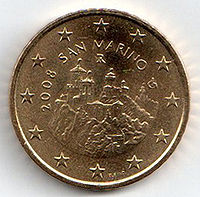 San Marino Euro 50 cent (2008).
San Marino Euro 50 cent (2008).
Although San Marino is not a European Union member, it is allowed to use the euro as its currency by arrangement with the Council of the European Union; it is also granted the right to use its own designs on the national side of the euro coins. Before the euro, the Sammarinese lira was pegged to, and exchangeable with, the Italian lira. The small number of Sammarinese euro coins, as was the case with the lira before it, are primarily of interest to coin collectors.
Other key industries are banking, electronics, and ceramics. The main agricultural products are wine and cheese.
San Marino's postage stamps, which are valid for mail only within the country, are mostly sold to philatelists and are a source of income. San Marino is a member of the Small European Postal Administration Cooperation.
The per capita level of US$55,449 and standard of living are comparable to those of Switzerland. San Marino imports goods such as food from Italy.
Taxation
 Borgo Maggiore, one of San Marino's tourist attractions.
Borgo Maggiore, one of San Marino's tourist attractions.
The corporate profits tax rate in San Marino is 19 percent. Capital gains are subject to a five percent tax; interest is subject to a 13 percent withholding tax.
In 1972, a value added taxation (VAT) system was introduced in Italy, and was applied in San Marino, in accordance with the 1939 friendship treaty. In addition, a tax on imported goods, to be levied by San Marino, was established. Such taxes, however, were not, and are not, applied to national products. Until 1996, goods manufactured and sold in San Marino were not subject to indirect taxation.
Under the European Union customs agreement, San Marino continues to levy taxes, the equivalent of an import duty, on imported goods. Also, a general VAT was introduced, in replacement of the Italian VAT.
Tourism
Main article: Tourism in San MarinoThe tourist sector contributes over 2.2% of San Marino's GDP, with approximately 2 million tourists visiting in 2009.[18][19]
Demographics
Main article: Demographics of San MarinoSan Marino has a population of approximately 33,000, with 4,800 foreign residents, most of whom are Italian citizens. Another 12,000 Sammarinese live abroad (5,700 in Italy, 3,000 in the USA, 1,600 in Argentina and 1,900 in France).[20]
The first census since 1976 was held in 2010. Results are expected within the end of 2011, however, 13 per cent of families did not return their forms.
The language spoken is Italian; Emiliano-Romagnolo is widely spoken too. Citizens of San Marino enjoy one of the highest life expectancies in the world.[1]
Religion
Main article: Religion in San MarinoSan Marino is a predominantly Catholic state[1] — over 97% of the population profess the Catholic faith, but it is not the established religion. Approximately half of those who profess to be Catholic practise the faith.[21] There is no episcopal see in San Marino. Historically, the various parishes in San Marino were divided between two Italian dioceses, mostly in the Diocese of Montefeltro, and partly in the Diocese of Rimini. In 1977, the border between Montefeltro and Rimini was readjusted so that all of San Marino fell within the diocese of Montefeltro. The bishop of Montefeltro-San Marino resides in Pennabilli, in Italy.
However, there is a provision under the income tax rules that the tax payers have the right to request for allocation of 0.3 % of their income tax to the Catholic Church or to "other" charities. The churches include the two religious groups of the Waldensian Church and Jehovah's Witnesses.
The Roman Catholic Diocese of San Marino-Montefeltro was until 1977 the historic diocese of Montefeltro. It is a suffragan of the archdiocese of Ravenna-Cervia.[22] The current diocese includes all the parishes of San Marino. The earliest mention of Montefeltro, as Mona Feretri, is in the diplomas by which Charlemagne confirmed the donation of Pepin. The first known bishop of Montefeltro was Agatho (826), whose residence was at San Leo. Under Bishop Flaminios Dondi (1724) the see was again transferred to San Leo, but later it returned to Pennabilli. The historic diocese was a suffragan of the archdiocese of Urbino.[23]
There has been a Jewish presence in San Marino for at least 600 years.[24] The first mention of Jews in San Marino dates to the late 14th century, in official documents recording the business transactions of Jews. There are many documents throughout the 15th to 17th centuries describing Jewish dealings and verifying the presence of a Jewish community in San Marino. Jews were required to wear special badges and live by specific restrictions, but were also permitted official protection by the government.
During World War II, San Marino provided a harbor for more than 100,000 Italians (approximately ten times the Samarrinese population at the time) and Jews from Nazi persecution. Today, there are only small numbers of Jews in San Marino.[25]
Military
Main article: Military of San MarinoSan Marino has one of the smallest military forces in the world. National defence is, by arrangement, the responsibility of Italy's armed forces. Different branches have varied functions, including: performing ceremonial duties; patrolling borders; mounting guard at government buildings; and assisting police in major criminal cases. The police are not included in the Military of San Marino.
Crossbow Corps
Although once at the heart of San Marino's army, the Crossbow Corps is now a ceremonial force of approximately eighty volunteers. Since 1295, the Crossbow Corps has provided demonstrations of crossbow shooting at festivals. Its uniform is medieval in design, and although a statutory military unit, it has no military function today.
Guard of the Rock
Three members of the Guard of the Rock
The Guard of the Rock is a front-line military unit in the San Marino armed forces, a state border patrol, with responsibility for patrolling borders and defending them. In their role as Fortress Guards they are responsible for guarding the Palazzo Pubblico in San Marino City, the seat of national Government. In this role they are the forces most visible to tourists, and are known for their colourful ceremony of Changing the Guard. Under the 1987 statute the Guard of the Rock are all enrolled as 'Criminal Police Officers' (in addition to their military role) and assist the police in investigating major crime. The uniform of the Guard of the Rock is a distinctive red and green.
Guard of the Council Great and General
The Guard of the Council Great and General commonly known as The Guard of the Council or locally as the 'Guard of Nobles', formed in 1740, is a volunteer unit with ceremonial duties. Due to its striking blue, white, and gold uniform, it is perhaps the best-known part of the Sammarinese military, and appears on countless postcard views of the republic. The functions of the Guard of the Council are to protect the Captains Regent, and to defend the Great and General Council during its formal sessions. They also provide a ceremonial bodyguard to government officials on festivals of both state and church.
The Company of Uniformed Militia
In former times, all families with two or more adult male members were required to enroll half of them in the Company of Uniformed Militia. This unit remains the basic fighting force of the armed forces of San Marino, but is largely ceremonial. It is a matter of civic pride for many San-Marinese to belong to the force, and all citizens with at least six years residence in the republic are entitled to enroll.
The uniform is dark blue, with a kepi bearing a blue and white plume. The ceremonial form of the uniform includes a white cross-strap, and white and blue sash, white epaulets, and white decorated cuffs.
The Military Ensemble
Formally this is part of the Army Militia, and is the ceremonial military band of San Marino. It consists of approximately fifty musicians. The uniform is similar to that of the Army Militia. Military Ensemble music accompanies most state occasions in the republic.
The Gendarmerie
Established in 1842, the Gendarmerie of San Marino is a militarised law enforcement agency. Its members are full-time and have responsibility for the protection of citizens and property, and the preservation of law and order.
The entire military corps of San Marino depends upon the co-operation of full-time forces and their retained (volunteer) colleagues, known as the Corpi Militari Volontari, or Voluntary Military Force.
Transport
Main article: Transport in San MarinoThere are 220 km of roads in the country, the main road being the San Marino Superhighway. Sammarinese authorities license private vehicles with distinctive licence plates which are white with blue figures and the coat of arms, usually a letter followed by up to four numbers. Many vehicles also carry the international vehicle identification code (in black on a white oval sticker), which is "RSM".
There are no airports in San Marino, but there is an international heliport located in Borgo Maggiore. Most tourists who arrive by air land at Federico Fellini International Airport close to the city of Rimini, then make the transfer by bus.
Two rivers flow through San Marino, but there is no major water transport, and no major port or harbour.
Public transport
San Marino has limited public transport facilities. There is a regular bus service between Rimini and the city of San Marino, popular with both tourists and tourist industry workers commuting to San Marino from Italy. This service stops at approximately twenty locations in Rimini and within San Marino, with its two terminus stops at Rimini railway station and San Marino coach station.
A limited licensed taxi service operates nationwide. There are seven licensed taxi operating companies in the republic,[26] and Italian taxis regularly operate within San Marino when carrying passengers picked up in Italian territory.
 Aerial tramway to Monte Titano
Aerial tramway to Monte Titano
There is a 1.5 km (0.93 mi) aerial tramway connecting the city of San Marino on top of Monte Titano with Borgo Maggiore, a major town in the republic, with the second largest population of any San Marinese settlement. For the visitor the aerial tramway gives the best views of Borgo Maggiore, as the cars sweep low over the rooftops of the main town square. From here a further connection is available to the nation's largest settlement, Dogana, via the local bus service.
Two aerial tramway cars (gondolas) operate in opposition on a cable, and service is provided at roughly fifteen minute intervals throughout the day. A third vehicle is available on the system, a service car for the use of engineers maintaining the tramway.
Railway
Today, there is no railway in San Marino, but for a short period prior to World War II, it had a single narrow-gauge line, connecting the country with the Italian rail network at Rimini. Due to the difficulties in accessing the capital, San Marino City, with its mountain-top location, the terminus station was planned to be located in the village of Valdragone, but was extended to reach the capital through a steep and winding track comprising many tunnels. The railway was opened on 12 June 1932.[27] An advanced system for its time, it was an electric railway, powered from overhead cables. It was well built and had a high frequency of passengers, but was almost completely destroyed during World War II. Many facilities such as bridges, tunnels, and stations remain visible today, and some have been converted to parks, public footpaths, or traffic routes.
Culture
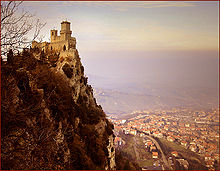 Photo of Guaita
Photo of Guaita A painting in the Museo di Stato di San Marino by Pompeo Batoni
A painting in the Museo di Stato di San Marino by Pompeo Batoni
The Three Towers of San Marino are located on the three peaks of Monte Titano in the capital. They are depicted on both the Flag of San Marino and its coat of arms. The three towers are: Guaita, the oldest of the three (it was constructed in the 11th century); the thirteenth-century Cesta, located on the highest of Monte Titano's summits; and the fourteenth-century Montale, on the smallest of Monte Titano's summits, still privately owned.
San Marino has a famous cake known as Torta Di Tre Monti ("Cake of the Three Towers"), a layered wafer cake covered in chocolate.
Love Orchestra, a Gian Luca "Luke" Mazza new age music project, comes from the Republic of San Marino. During concerts overseas, the San Marino flag is shown on the stage.
University
The Università degli Studi della Repubblica di San Marino (University of the Republic of San Marino)[28] is the main university, which includes the Scuola Superiore di Studi Storici di San Marino (Advanced School of Historical Studies), a distinguished research and advanced international study center governed by an international Scientific Committee coordinated by professor Luciano Canfora. Other important institutes are the Istituto Musicale Sammarinese (Sammarinese Musical Institute)[29] and the Akademio Internacia de la Sciencoj San Marino or Accademia Internazionale delle Scienze San Marino (International Academy of Sciences San Marino).[30] The latter is known for adopting Esperanto as the language for teaching and for scientific publications; further, it makes wide use of e-learning.
Italian author Umberto Eco has attempted to create a "university without physical structures" in San Marino.[31]
Sport
Main article: Sport in San MarinoSee also: San Marino at the Olympics and Football in San MarinoSan Marino, along with Italy, enjoy sports and football (soccer) is its most popular sport. Basketball and volleyball are also popular. The three sports have their own federations, the San Marino Football Federation, the San Marino Basketball Federation and the San Marino Volleyball Federation.
The San Marino Championship, founded under the auspices of the FSGC (San Marino Football Federation), is the premier footballing competition in San Marino. The fifteen teams that take part in the competition are split into two groups of eight and seven teams. The top three from each section at the end of the regular season progress into a semi-knockout style Championship Playoff. Prior to 2007, the playoff champion earned a spot in the preliminary rounds of the UEFA Cup. In 2007, UEFA granted San Marino a spot in the 1st Qualifying Round of the Champions League. The domestic cup winner also gets a spot in the UEFA Cup qualifying stages. 2007 league champions S.S. Murata was the first team to represent San Marino in the Champions League when they participated in the 2007–08 competition, losing to Finnish team Tampere United. San Marino also has a representative in the Italian system, with San Marino Calcio playing in the fourth tier of Italian football, Serie C2/B. San Marino play their home matches in the Sanmarinese at the Stadio Olimpico of Serravalle.
The San Marino national football team played its first unofficial international match in 1986, in which it suffered a 0–1 defeat to the Canadian Olympic team. Its first competitive outing was on 14 November 1990, a 0–4 loss against Switzerland in the European Championship qualifier. These defeats set the tone for most of the following outings of the team, who are regarded as easy victories in the qualifying sections of the European Championship and the World Cup.
They had a brief moment of glory when they faced England in a World Cup qualifier on 17 November 1993 and took the lead through Davide Gualtieri after just 8.3 seconds—still the fastest goal in World Cup competition.[32] Until recently, San Marino's international record was one of almost total failure, with famous draws against Turkey and Latvia being the only partial successes in an international career that contains over seventy defeats. However, on the 29 April 2004, San Marino recorded their first ever win, with a 1–0 victory over Liechtenstein in an international friendly. Andy Selva scored the only goal in a close game that finally gave this tiny republic a footballing victory.
On 6 September 2006, San Marino suffered their biggest ever defeat, losing 13–0 to world giants Germany in the Stadio Olimpico. It was also the largest goal margin defeat in European Championship Qualifying history. In the same competition on 7 February 2007, they came within eight seconds of the best result in their history. They were level at 1–1 with the Republic of Ireland after ninety-four minutes when Stephen Ireland scored within eight seconds of the final whistle. The goal scored by San Marino was their European Qualifying first goal since losing 4–1 to Austria in 1998.
As of September 2011, San Marino is 203rd in the FIFA world rankings—jointly last with three other teams.[33]
A Formula One race, the San Marino Grand Prix, was named after the state, although it did not take place there. It was held at the Autodromo Enzo e Dino Ferrari in the Italian town of Imola, about 100 km northwest of San Marino, along the Via Emilia. The race was etched in infamy after two fatal accidents occurred at the 1994 Grand Prix, when Ayrton Senna and Roland Ratzenberger were killed. The race was removed from the calendar in 2007.
The San Marino and Rimini's Coast motorcycle Grand Prix was reinstated in the schedule in 2007 and takes place at the Misano World Circuit, as does San Marino's round of the World Superbike Championship.
Manuel Poggiali is one of San Marino's most successful sportsmen. He has won two motorcycle World Championships, in 2001 with 125 cc bikes and in 2003 with 250 cc bikes. Another successful San Marino motorcycle rider is Alex De Angelis, a race winner in the 250 cc class, who is currently racing in the Moto2 class, with the country of San Marino itself being his main sponsor.
San Marino has a professional baseball team, T & A San Marino, which plays in the top division of Italian professional baseball, the Serie A1. It has participated in the European Cup tournament for the top European professional baseball teams several times, hosting the event in 1996, 2000, 2004, and 2007. It won the championship in 2006 and was a runner-up in 2010.[34]
The long climb up to the top of San Marino has become a mecca for thousands of recreational road cyclists who train in nearby Misano every spring and autumn.
San Marino has had little success at the Olympic Games, winning no medals. At the 2004 and 2008 games, three clay target shooters achieved the highest positions. In this sport, San Marino also hosted a competition in the 2009 ISSF World Cup.
Cuisine
Main article: Cuisine of San Marino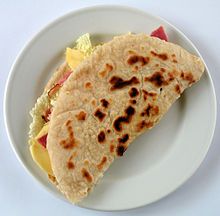 A piadina, a dish characteristic of San Marino and its surrounding Italian region, Romagna.
A piadina, a dish characteristic of San Marino and its surrounding Italian region, Romagna.
The cuisine of San Marino is strongly similar to Italian, especially that of the adjoining Emilia-Romagna and Marche regions, but it has a number of its own unique dishes and products. Its best known is probably the Torta Tre Monti ("Cake of the Three Mountains" or "Cake of the Three Towers"), a wafer layered cake covered in chocolate depicting The Three Towers of San Marino. The country also has a small wine industry.
LGBT
Main article: LGBT rights in San MarinoLesbian, gay, bisexual, and transgender (LGBT) persons in San Marino may face legal challenges not experienced by non-LGBT residents. Both male and female same-sex sexual activity are legal in San Marino, but households headed by same-sex couples are not eligible for the same legal protections available to opposite-sex couples. The total ban on homosexuality was abolished in San Marino in 1864. In 1974, Parliament passed a new penal code containing Article 274, punishing with imprisonment from three months to one year those "regularly committing lustful acts with a person of the same sex, if from that act public scandal is derived". Article 274 was subsequently repealed in September 2004.[citation needed]
UNESCO
The site “San Marino: Historic Centre and Mount Titano” has become part of the UNESCO World Heritage List in 2008. The decision was taken during the 32nd Session of the UNESCO World Heritage Committee composed of 21 Countries convened in Québec, Canada.
Music
Main articles: Music of San Marino and San Marino in the Eurovision Song ContestThe country has a long and rich musical tradition, closely linked to that of Italy, but which is also highly independent in itself. In the 17th century, composers like the Sammarinese Francesco Maria Marini di Pesaro wrote some of the finest pieces of the era.
San Marino entered the Eurovision Song Contest for the first time, in 2008, with the band, Miodio, singing "Complice". The group failed to make it to the final from the first semi-final and finished 19th out of a field of 19 with 5 points. They came behind Estonia's Kreisiraadio who came 18th with 8 points. San Marino gave its first ever highest (12) points to Greece. In 2011 San Marino decided to come back to the Eurovision Song Contest with Senit singing the song "Stand By". She finished 16th in a field of 19 in the semi-final, coming behind Croatia's Daria Kinzer with the song "Celebrate" and coming in front of Norway's Stella Mwangi, who sang "Haba Haba". In the final voting, San Marino gave their 12 points to Raphael Gualazzi and his song "Madness Of Love" from Italy.
Public holidays and festivals
Date Name Explanation 1 January New Year's Day Festival marking the beginning of the new year. 6 January Epiphany Commemorates the visit of the three Wise Men or magi to the infant Jesus. 5 February Feast of Saint Agatha Commemoration of St. Agatha, Patroness of the Republic, as well as liberation from foreign rule. variable * Easter Resurrection of Jesus. variable ** Easter Monday Monday after Easter day. 25 March Anniversary of the Arengo Anniversary of the Arengo and the Festa delle Milizie (Feast of the Militants). 1 May Labour Day Celebration of workers and employees. variable *** Corpus Domini Commemoration of the body and blood of Jesus Christ. 28 July Liberation from Fascism Commemoration of the fall of the Sammarinese Fascist Party. 15 August Ferragosto (Assumption) Commemoration of the Virgin Mary's direct assumption into heaven upon her death. 3 September The Feast of San Marino and the Republic National feast of San Marino, celebrating the origin of the Republic in 301. 1 November All Saints' Day Feast dedicated to all saints. 2 November Commemoration of all those who died at war Remembrance of all those who gave their lives for San Marino in war. 8 December Immaculate Conception Remembrance of the Virgin Mary's conception without original sin. 24 December Christmas Eve Day before the commemoration of the birth of Jesus. 25 December Christmas Birth of Jesus. 26 December St. Stephen's Day Commemoration of the death of Saint Stephen, the first Christian martyr. 31 December New Year's Eve Celebration which closes and marks the end of the year. * Easter: the first Sunday after the full moon and the March equinox
** Easter Monday: the Monday after Easter day
*** Corpus Domini: the first Thursday after Trinity SundaySee also
- Outline of San Marino
- Index of San Marino-related articles
- Associazione Guide Esploratori Cattolici Sammarinesi
- City State
- Communications in San Marino
- Foreign relations of San Marino
- Most Serene Republic
- San Marino Grand Prix
- Autodromo Enzo e Dino Ferrari, the circuit that hosted the San Marino Grand Prix
References
- ^ a b c d e f San Marino entry at The World Factbook
- ^ [1], Upeceds, Government of San Marino. Accessed on March 31, 2011.
- ^ a b c d Conto della Generazione dei Redditi Nazionali, Upeceds, Government of San Marino. Accessed on June 6, 2010.
- ^ a b c d World Development Indicators, World Bank. Note: "PPP conversion factor, GDP (LCU per international $)" for Italy was used.
- ^ "San Marino". UNECE Statistics Programme. UNECE. 2009. http://www.unece.org/stats/profiles2009/san_marino.pdf. Retrieved 13 March 2010.
- ^ a b "San Marino". Encylopædia Britannica. 2022. http://www.britannica.com/EBchecked/topic/521449/San-Marino. Retrieved 1 March 2011.
- ^ "San Marino Historical Origins and Legends". Sanmarinosite.com. http://www.sanmarinosite.com/eng/leggenda.html. Retrieved 2009-10-24.
- ^ Law Library of United States Congress. "Guide to Law Online: San Marino". http://www.loc.gov/law/help/guide/nations/sanmarino.html. Retrieved 2008-05-21.
- ^ "From 1500 to beginning 1800, Napoleon in San Marino". Sanmarinosite.com. http://www.sanmarinosite.com/eng/napoleone.html. Retrieved 2009-10-24.
- ^ "San Marino". United States Diplomatic History. U. S. Department of State. http://history.state.gov/countries/san-marino. Retrieved 2011-05-29.
- ^ Irving Wallace, The Book of Lists 3
- ^ "San Marino e la Prima Guerra Mondiale". Educazione.sm. http://www.educazione.sm/scuola/servizi/CD_virtuali/lavori_scuole/sanmarino/prima_guerra_mondiale.htm. Retrieved 2009-10-24.
- ^ "Guerre Mondiali e Fascismo nella storia di San Marino". Sanmarinosite.com. http://www.sanmarinosite.com/storia/guerremo.html. Retrieved 2009-10-24.
- ^ "Fishery and Aquaculture Country Profiles: Nauru". Food and Agriculture Organization of the United Nations. http://www.fao.org/fishery/countrysector/FI-CP_NR/en. Retrieved 27 May 2010.
- ^ Meteo San Marino – The National Center of Meteorology And Climatology of San Marino
- ^ (Italian) Article with the list of curazie on the official Sanmarinese electoral website
- ^ "San Marino, primo capo di Stato disabile "Via tutte le barriere architettoniche" – esteri". Repubblica.it. 2007-10-01. http://www.repubblica.it/2007/10/sezioni/esteri/disabile-san-marino/disabile-san-marino/disabile-san-marino.html. Retrieved 2009-10-24.
- ^ "Background Note: San Marino". U.S. State Department. February 2010. http://www.state.gov/r/pa/ei/bgn/5387.htm. Retrieved 13 March 2010.
- ^ "Turismo: San Marino fa i conti con la recessione economica, l'Italia guarda con fiducia al 2010" (in Italian). San Marino RTV. 11 January 2010. http://www.sanmarinortv.sm/economia/default.asp?id=33&id_n=39203. Retrieved 13 March 2010.
- ^ "San Marino: censimento per scovare residenze fittizie" (in Italian). San Marino Notizie. 5/08/10. http://www.sanmarinonotizie.com/?p=13707. Retrieved 8 November 2011.
- ^ World and Its Peoples. Marshall Cavendish. 2009. p. 856. ISBN 0761478930. http://books.google.com/books?id=xcYVmUyHG2AC&pg=PA856.
- ^ Catholic Hierarchy page
- ^ http://www.newadvent.org/cathen/10528a.htm Catholic Encyclopedia article
- ^ jewishencyclopedia.com
- ^ jewishvirtuallibrary.org
- ^ Licensed taxi companies are listed on the Government tourism website.
- ^ Internacia Fervojisto (International Railways), 2005.6, p. 85. In Esperanto
- ^ "Università degli Studi di San Marino". Unirsm.sm. http://www.unirsm.sm/. Retrieved 2009-10-24.
- ^ "Istituto Musicale Sammarinese". Ims.sm. http://www.ims.sm/. Retrieved 2009-10-24.
- ^ "Accademia Internazionale delle Scienze". Ais-sanmarino.org. http://www.ais-sanmarino.org/. Retrieved 2009-10-24.
- ^ Umberto Eco biography
- ^ "h2g2 – The Fastest Goal in the History of the World Cup". BBC. http://www.bbc.co.uk/dna/h2g2/A3952361. Retrieved 2009-10-24.
- ^ "The FIFA/Coca-Cola World Ranking". FIFA.com. 2009-08-20. http://www.fifa.com/worldfootball/ranking/lastranking/gender=m/fullranking.html#confederation=0&rank=179&page=5. Retrieved 2009-10-24.
- ^ "2008 Mister-Baseball Final European Top 50 – fact, certain, about, 2008, European, baseball, season, club, dominated, This". Mister Baseball. 2007-11-06. http://www.mister-baseball.com/2008-misterbaseball-final-european-top-50/. Retrieved 2009-10-24.
External links
- Chief of State and Cabinet Members
- Secretary of State for External Relations and Politics
- San Marino entry at The World Factbook
- San Marino from UCB Libraries GovPubs
- San Marino at the Open Directory Project
- Wikimedia Atlas of San Marino
- San Marino—San Marino Tourism Site
- Meteo San Marino National Center Of Meteorology and Climatology of San Marino, Local Forecast and Webcams
- Musei di Stato della Repubblica di San Marino
- History of San Marino: Primary Documents from EUdocs
- Renata Tebaldi International Voice Competition
- San Marino from allcountries.eu
- San Marino travel guide from Wikitravel
- Visit San Marino—Official San Marino Tourism Site Contrada Omagnano
- (Italian) General information of San Marino: Politics, Institutions and very other
- San Marino: excerpt from a 1769 Guidebook
- Score San Marino Soccer— Score live san Marino
San Marino Politics Constitution · Captains Regent · Cabinet · Parliament · Elections · Political parties · Military · Coat of arms · Foreign relations · Capital punishment · Law enforcement · Council of Europe · European microstates · European UnionHistory Geography Economy Society Outline · Index Sovereign states and dependent territories of Europe Sovereign states Albania · Andorra · Armenia · Austria · Azerbaijan · Belarus · Belgium · Bosnia and Herzegovina · Bulgaria · Croatia · Cyprus · Czech Republic · Denmark · Estonia · Finland · France · Georgia · Germany · Greece · Hungary · Iceland · Ireland · Italy · Kazakhstan · Latvia · Liechtenstein · Lithuania · Luxembourg · Macedonia · Malta · Moldova · Monaco · Montenegro · Netherlands · Norway · Poland · Portugal · Romania · Russia · San Marino · Serbia · Slovakia · Slovenia · Spain · Sweden · Switzerland · Turkey · Ukraine · United Kingdom · Vatican City

States with limited recognition Dependencies and other territories DenmarkFinlandUnited KingdomClimate of Europe Sovereign
states- Albania
- Andorra
- Armenia
- Austria
- Azerbaijan
- Belarus
- Belgium
- Bosnia and Herzegovina
- Bulgaria
- Croatia
- Cyprus
- Czech Republic
- Denmark
- Estonia
- Finland
- France
- Georgia
- Germany
- Greece
- Hungary
- Iceland
- Ireland
- Italy
- Kazakhstan
- Latvia
- Liechtenstein
- Lithuania
- Luxembourg
- Macedonia
- Malta
- Moldova
- Monaco
- Montenegro
- Netherlands
- Norway
- Poland
- Portugal
- Romania
- Russia
- San Marino
- Serbia
- Slovakia
- Slovenia
- Spain
- Sweden
- Switzerland
- Turkey
- Ukraine
- United Kingdom
- (England
- Northern Ireland
- Scotland
- Wales)
- Vatican City
States with limited
recognition- Abkhazia
- Kosovo
- Nagorno-Karabakh
- Northern Cyprus
- South Ossetia
- Transnistria
Dependencies
and other territoriesOther entities - European Union
- Sovereign Military Order of Malta
Council of Europe Institutions Secretary General · Committee of Ministers · Parliamentary Assembly · Congress · Court of Human Rights · Commissioner for Human Rights · Commission for the Efficiency of Justice · Commission against Racism and Intolerance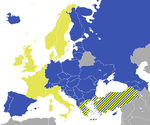
Members FullAlbania · Andorra · Armenia · Austria · Azerbaijan · Belgium · Bosnia and Herzegovina · Bulgaria · Croatia · Cyprus · Czech Republic · Denmark · Estonia · Finland · France · Georgia · Germany · Greece · Hungary · Iceland · Ireland · Italy · Latvia · Liechtenstein · Lithuania · Luxembourg · Macedonia1 · Malta · Moldova · Monaco · Montenegro · Netherlands · Norway · Poland · Portugal · Romania · Russia · San Marino · Serbia · Slovakia · Slovenia · Spain · Sweden · Switzerland · Turkey · Ukraine · United KingdomObserverFormer1 Provisionally referred to by the Council of Europe as "the former Yugoslav Republic of Macedonia"; see Macedonia naming dispute. Member nations Andorra · Angola · Bolivia · Brazil · Cape Verde · Chile · Colombia · Costa Rica · Côte d'Ivoire · Cuba · Dominican Republic · East Timor · Ecuador · El Salvador · France · Guatemala · Guinea-Bissau · Haiti · Honduras · Italy · Mexico · Moldova · Monaco · Mozambique · Nicaragua · Panama · Paraguay · Peru · Philippines · Portugal · Romania · San Marino · São Tomé and Príncipe · Senegal · Spain · Uruguay · VenezuelaPermanent observers Official languages Coordinates: 43°56′N 12°28′E / 43.933°N 12.467°E
Categories:- San Marino
- European countries
- Enclaves
- Italian-speaking countries
- Landlocked countries
- Republics
- Liberal democracies
- Diarchies
- Countries that are enclaves of Italy
- Member states of the United Nations
Wikimedia Foundation. 2010.



